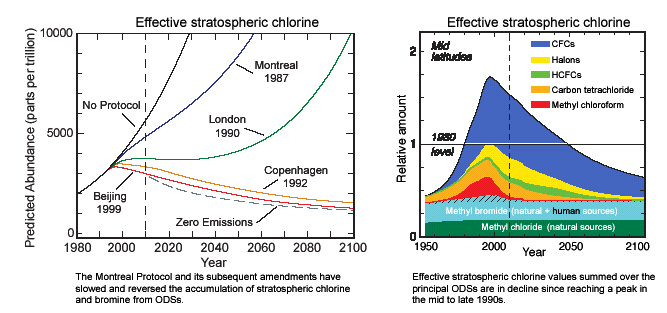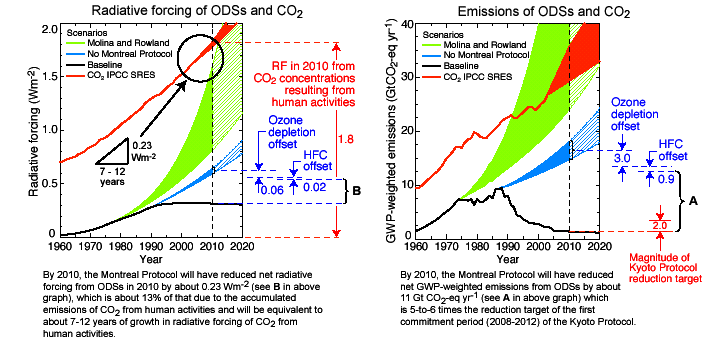
|
||||||||||||||||||||||||
|
Dual benefits ozone protocol: protecting Ozone layer and Climate Press release; 5 March 2007 The Netherlands Environmental Assessment AgencyThe 1987 Montreal Protocol - restricting the use of ozone-depleting substances - has helped to both reduce global warming and protect the ozone layer. Without this protocol, the amount of heat trapped due to ozone-depleting substances would be double that of today. The benefits to the climate, achieved by the Montreal Protocol alone, at present greatly exceed the initial target of the Kyoto Protocol. This is shown in research led by the Netherlands Environmental Assessment Agency, which will be published this Monday in Proceedings of the National Academy of Sciences (USA). The effects of the Montreal Protocol on the climate will decrease in the future, while emission reductions after 2012 under the Kyoto Protocol will potentially have a much larger effect on the climate. Antarctic ozone holeChlorofluorocarbons (CFCs) and other ozone depleting substances are now globally recognized as the main cause of the observed depletion of the ozone layer. In 1974, Molina and Rowland provided an ‘early warning’, when they first recognized the potential of CFCs to deplete stratospheric ozone. Concern was further heightened in 1985, by the discovery of the ozone hole over Antarctica. The 1987, the Montreal Protocol on Substances that Deplete the Ozone Layer formally recognized the significant threat of ozone-depleting substances to the ozone layer and provided a mechanism to reduce and phase-out global production and use of these compounds. According to research the ozone layer is currently starting to recover. Greenhouse gases and the Kyoto ProtocolOzone depleting substances also
contribute to the radiative forcing of climate change. Their current
contribution is about 20% of that of carbon dioxide (CO2). The Kyoto Protocol
of 1997 is a global treaty to reduce the emission of CO2, the leading
greenhouse gas, and five other gases. These gases do not deplete the ozone
layer. However, the substances that do, are not included in the Climate
Convention and its Dual benefitsAccording to research led by the Netherlands Environmental Assessment Agency, the Montreal Protocol has helped to both reduce global warming, and to protect the ozone layer. Without the reductions achieved under this Protocol, the amount of heat trapped due to ozone-depleting substances would be about double that of today. This has meant a gain of about 10 years of CO2 reductions. The climate benefits which are already achieved by the Montreal Protocol alone, are far larger than the reduction target set for the first commitment period of the Kyoto Protocol. However, these climate benefits due to the Montreal Protocol, will reduce further and further, as ozone depleting substances are being phased-out. Future benefitsNew measures under the Montreal Protocol, can result in additional, significant climate benefits, compared to the Kyoto Protocol reduction target. These new measures consist of removing CFCs present in existing applications (refrigerators, foams), and of limiting the production of not fully halogenated fluorocarbons (HCFCs), and/or of implementing the use of alternative gases with lower global warming potentials. Also, additional emission reductions after 2012 are being negotiated in the framework of the Kyoto Protocol. Such reductions have a potentially much larger effect on climate than those of the Montreal Protocol.
Climate Benefit of Montreal Protocol is 5 to 6 Times Larger than 1st Commitment Period of Kyoto Protocol
WILMINGTON, Del., March 5, 2007 - DuPont today reinforced the findings of a
group of leading scientists that show the Montreal Protocol treaty has had a
significant impact on protecting the Earth’s climate, as well as its ozone
layer.
Dr. Mack McFarland, DuPont chief atmospheric scientist, is a leading industry expert on climate change. A former scientist with the National Oceanic and Atmospheric Administration, he is one of the authors of an article stating that the international Montreal Protocol treaty benefitted the Earth's climate, as well as its protective ozone layer. The Montreal
Protocol on Substances that Deplete the Ozone Layer was signed in September
1987. It restricts the use of ozone-depleting substances, including
chlorofluorocarbons (CFCs) and hydrochlorofluorocarbons (HCFCs), which also are
greenhouse gases. After two decades, the treaty has led to substantial
reductions in the emissions of ozone depleting substances. Research indicates
that the ozone layer is now recovering. DuPont has reduced greenhouse gas
emissions more than 70 percent since 1991, with $3 billion in avoided energy
costs. Those energy savings are based on the use of improved process controls;
optimization of energy generation and distribution at its facilities; new
technologies with lower energy consumption, and; one of the biggest factors –
improved yields from DuPont’s manufacturing processes. DuPont also is reducing
the use of fossil fuels by employing alternative energy sources such as landfill
gas. |






